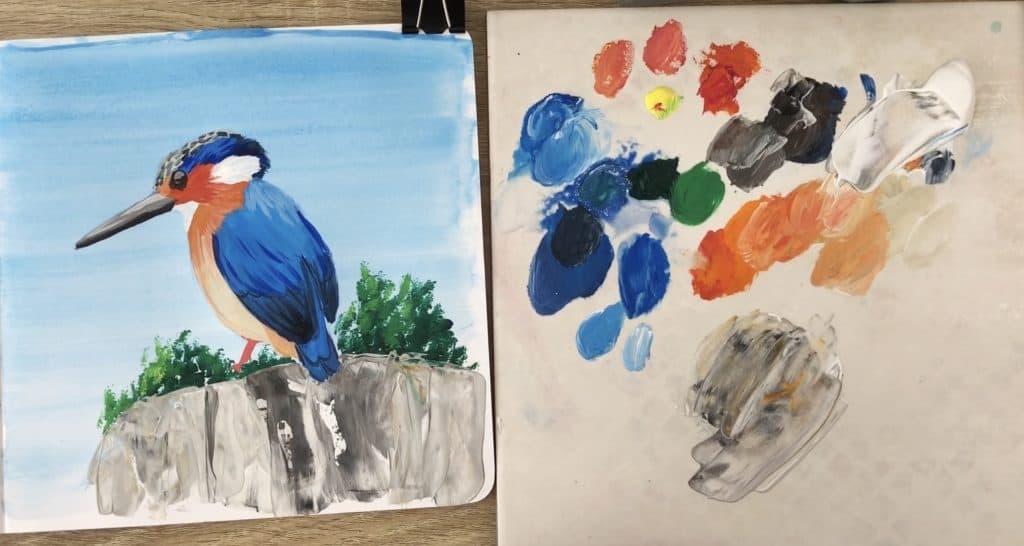Gouache Techniques for Illustration
Water-based gouache is a paint that produces vibrant, opaque colors and is suitable for both fine painting and illustration. The medium gives artists control over their creations and the freedom to make dramatic compositions with strikingly gorgeous colors.
This article will examine numerous illustration methods using gouache. Artists can use gouache in various ways, from simple techniques like mixing and layering colors to more complex ones like adding highlights and shadows.
Table of Contents
- Basic Gouache Techniques:
- Advanced Gouache Techniques:
- Tips for Illustrating with Gouache:
- Conclusion:
Basic Gouache Techniques:
Several basic gouache techniques can be used in the illustration. Here are a few examples:
Mixing and layering colors:
Various tints and hues can be produced by combining different gouache paints. To mix the paints, you can do so on your painting surface, a palette, or a mixing tray. You can make more intricate and nuanced hues by layering various colors on top of one another.
Creating washes and gradients:
You can make a wash by thinning the gouache with water and spreading it in an even, thin layer. This is a fantastic method to add depth or a subtle background to your artwork. A wet brush can also be used to mix colors and make gradients.
Adding details and textures:
Gouache may provide a variety of textures and points to an illustration. You can use a wet brush to draw precise, clean lines or a dry brush approach to add texture. Additionally, you can experiment with various brush strokes and mark-making methods to produce multiple effects.
By learning these fundamental gouache methods, you may produce images with vivid, rich colors and a variety of effects.

Advanced Gouache Techniques:
You can experiment with more sophisticated illustration techniques once you have a solid basis in fundamental gouache techniques. Here are a few illustrations:
Creating highlights and shadows:
Your paintings can have a stronger sense of dimension and realism by adding highlights and shadows. To give the appearance of light, shadow, or contrast, use complementary hues or lighter and darker variations of the same color.
Blending and smoothing:
Gouache can be mixed and smoothed to provide a more subtle or realistic look. You can blend the paint with a brush and smooth rough edges with a wet brush. I’ve found six different ways to blend gouache.

Playing around with various brush and mark-making methods:
With gouache, you can create a wide range of brushstrokes and mark-making styles, from loose and expressive to precise. By experimenting with various techniques, you can develop your style and give your illustrations more life and character. The type of brush you’ll use for painting will change the style of your artwork.
Master these advanced gouache painting techniques and your illustrations will take on a new level of depth, realism—and expressive power.
Tips for Illustrating with Gouache:
As you work with gouache for illustration, some tips and tricks can help you get the most out of this medium. Here are a few to consider:
Mixing and storing gouache:
Gouache paints can dry out quickly, so mixing only as much as you need is important. You can use an airtight palette to store your paint, so it stays fresh and creamy. And if your paint is dry, you can see some tips here.
Choosing the suitable surface and support:
Gouache can be used on various surfaces, including watercolor paper, bristol board, and more. You can get a sense of each substrate’s distinctive characteristics and outcomes by experimenting with various of them. It’s crucial to select the support that works with the illustration you’ve made. A thinner surface, like watercolor paper, may be more suited for looser, more expressive work, while thicker support, like bristol board, may be preferable for making intricate images.

Using reference images and color swatches:
You can produce more precise and well-coordinated illustrations using reference pictures and color swatches. Use reference photos to direct your composition and perspective, and use color swatches to ensure your colors are harmonious and consistent.
You can use these suggestions to aid you with your gouache painting projects.
Conclusion:
We looked at a variety of gouache illustration techniques in this article. You have mastered gouache to produce various effects in your works, from simple methods like color blending and layering to more complex ones like adding highlights and shadows.
Additionally, we have talked about how to mix and store gouache paint, select the best surface and support, use reference photos and color swatches, and more.
You can use gouache to produce great illustrations with rich, brilliant colors and dynamic, expressive qualities by mastering these techniques and heeding this advice. To bring your artistic concept to life, pick up some paint and explore these approaches!






